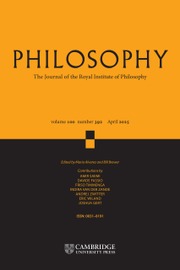Article contents
What′s Old in Derrida?
Published online by Cambridge University Press: 30 January 2009
Extract
Revolutions often retain more characteristics of the pre-revolutionary state than their makers like to admit. Characterizing the pre-revolutionary state as bad (otherwise there would have been no need for revolution), and wishing to accentuate the greatness of their doings, revolutionaries like to stress the differences between the previous state of affairs and the new one, and prefer to see the similarities as few and insignificant. They are frequently wrong.1
- Type
- Articles
- Information
- Copyright
- Copyright © The Royal Institute of Philosophy 1994
References
1 See, e.g., Christopher, Norris, Deconstruction: Theory and Practice, revised edition (London: Routledge, 1991), chaps. 1–3.Google ScholarSilverman, Hugh J., (ed.), Derrida and Deconstruction (New York: Routledge, 1989).Google ScholarRudolph, Gasche, The Tain of the Mirror (Cambridge, Mass: Harvard University Press, 1986).Google ScholarTaylor, Mark C., (ed.), Deconstruction in Context (Chicago: University of Chicago Press, 1986).Google Scholar
2 Deconstruction: Theory and Practice, 18.Google Scholar
3 Although Derrida never explicitly says that his alternative is not Western, he implies so in continuously associating the West with the logocentrism which he deconstructs. See, e.g., Positions (Paris: Minuit, 1972), 19; De la grammatologie (Paris: Minuit, 1967), 41;Google Scholar‘Le puits et la pyramide’, in Marges de la philosophie (Paris: Minuit, 1972; hereafter: Marges), 119–123;Google Scholar‘Les fins de l′homme’, in Marges, 161. ‘Racism′s Last Word’, trans. Peggy Kamuf, Critical Inquiry 12 (1985): 290–99.Google Scholar
4 Positions, 28–30. ‘La mythologie blanche’, in Marges, 301Google Scholar
5 Francis, Bacon, ‘The Great Instauration’, in The Philosophical Works of Francis Bacon, Robertson, John M. (ed.) (London: Routledge, 1905), 243.Google Scholar
6 Wieland, Christoph Martin, Gesprache unter vierAugen, in Sammtliche Werke, Gruber, J. G., (ed.), 50 vols. (Leipzig: Goschen, 1824–1877), XLII, 127–8.Google Scholar
7 Spurs: Nietzsche′s Styles/Eperons: Les styles de Nietzsche, bilingual edition, trans. Barbara, Harlow, (Chicago: Chicago University Press, 1978), 137.Google Scholar
8 A Treatise of Human Nature, Selby-Bigge, (ed.) Oxford: Clarendon, 1967, xxiii.Google Scholar
9 See Richard, Bernstein, ‘Serious Play: The Ethical-Political Horizon of Jacques Derrida’, The Journal of Speculative Philosophy 1 1987: 93–117.Google Scholar
10 Matthew 5, 5; 19,24.Google Scholar
11 Charles, Taylor, The Ethics of Authenticity Cambridge, Mass: Harvard University Press, 1992, 104.Google Scholar
12 See, e.g., Positions 56–7.Google Scholar
13 De la grammatologie, 62, 64.Google Scholar
14 De la grammatologie, 65–86.Google Scholar
15 Matthew 4.Google Scholar
16 Summa Theologiae II ii qu. 162 art. 5–8
17 Hume, David, A History of England, 6 vols. Philadelphia: Claxton, Remen and Haffelfinger, 1876, VI, 374.Google Scholar
18 Hume′s emphasis. Enquiries concerning Human Understanding, Selby-Bigge, (ed.), 2nd edition (Oxford: Clarendon, 1902), 165.Google Scholar
19 La verite en peinture, (Paris: Flammarion, 1978), 189.Google Scholar
20 Marges, 4.Google Scholar
21 Glas (Paris: Galilee, 1974).Google Scholar
22 ‘Beantwortung der Frage: Was ist Aufklarung?’ in Werke, Ernst Cassirer et. al, (eds), 11 vols. (Berlin: Bruno Cassirer, 1912–1922), IV, 169.Google Scholar
23 See Charles, Taylor, Sources of the Self: The Meaning of the Modern Identity (Cambridge, Mass.: Harvard University Press, 1989), chaps. 8, 9.Google Scholar
24 De la grammatologie 233.Google Scholar
25 See, e.g., ‘Cogito et histoire de la folie’, in L′Ecriture et la difference (Paris: Seuil, 1967).Google Scholar
26 I am very grateful to Saul Smilansky, Oded Balaban, Gabriel Motzkin, Avraham Mansbach, Mira Reich, and Mor Arazy for their helpful comments on an earlier draft of this paper.
- 3
- Cited by


